#contemporary central american textiles
Explore tagged Tumblr posts
Text








Currently at Marc Straus is Marie Watt’s impressive exhibition, Singing Everything.
From the press release-
A member of the Seneca Nation, Watt also has German-Scott ancestry. Her layered and complex influences include Indigenous knowledge and Iroquois proto-feminism, the matriarchal structures of certain Native American nations, the rise of social activism throughout the 20th century, and the anti-war and anti-hate content of the 1960s and 1970s music scene.
Central to the exhibition are three Sewing Circle pieces that were initiated at communal gatherings at the Whitney Museum of American Art in 2022. Watt’s sewing circles are cross generational, multicultural gatherings that she has been organizing for over a decade. Inspired by poet laurate Joy Harjo’s (Mvskoke/Creek) poem Singing Everything, Watt collects words from the participants of her sewing circles with the prompt, “what do you want to sing a song for in this moment?” The submitted words are then embroidered or sewn onto patches of fabric during the sewing circle. For the Whitney Sewing Circle, with over 300 participants, Watt, for the first time, used all the submitted words. Each panel is patterned in a way that stays true to the original hand. She thinks of ones handwriting as an extension of the cadence of one’s voice and in this project, it becomes part of a larger chorus. By composing large-scale wall works from these pieces of fabric, Watt creates collaborative artworks that interweave many individual handwritings, touches, and the stories that were exchanged in a shared space.
When entering the gallery, the visitor is greeted by a sweeping, 24-foot-long neon sign spelling out the words “deer, skywalker, heron, bass, great lake, woodland, beaver, turtle, wolf, lowly, muskrat, rat” in various hues that evoke the sky on the horizon during sunset and sunrise. While the piece represents a new direction in Watt’s work, she views neon as an extension of beadwork. The glass itself is at once thread and bead, and both neon and beads have a relationship to trade. They both envelop light, color, and sound, embodying sunrises and sunsets on the horizon.
Two blanket towers, her signature sculptural works, appear in the show but now with tin bells or jingles added to the reclaimed wool blankets. This choice of added material felt like a natural extension to Watt. She writes: “Blankets are danced and so are jingles, there is something healing about them both. They are objects of comfort” – by way of touch or sound. “Jingles acknowledge the Jingle Dress Dance which began as a healing ritual in the Ojibwe tribe in the 1910s during the influenza pandemic. The Jingle Dress Dance was also a radical act. In 1883, the United States banned Indigenous ceremonial gatherings. Though the ban was repealed in 1978 with the American Indian Religious Freedom Act, during its century-long prohibition the Jingle Dress Dance was shared with other tribal communities. Today it is a pow-wow dance and continues to be associated with healing. The relevance of this dance extends beyond pandemics.” By including jingles Watt brings the potential of sound into her work, adding to their visual and tactile aspects.
While drawing from long craft traditions such as textile or glass work, Watt is expanding her work by including contemporary stories and both individual and collective experiences. Her primary interest is to think about art as more experiential, rather than only visual, a direction she plans to explore further.
This exhibition closes 5/20/23.
#marie watt#marc straus#marc straus gallery nyc#nyc art shows#fabric art#neon#neon art#blankets#embroidery#sculpture#art installation#art
3 notes
·
View notes
Text
Filipino Americans have made significant contributions to arts and entertainment, showcasing their talent and cultural influence across various fields such as film, television, music, visual arts, and literature. These contributions are part of a larger narrative of Filipino Americans breaking barriers, expressing identity, and creating a lasting cultural impact.

1. Film and Television
Actors and Actresses:
Lea Salonga is one of the most famous Filipino American entertainers, known for her roles in Broadway musicals like Miss Saigon (for which she won a Tony Award) and as the singing voice of Disney princesses Jasmine (Aladdin) and Mulan (Mulan). Her achievements have inspired many in the Filipino American community.
Darren Criss, a Filipino American actor and singer, rose to fame on Glee and became a household name when he won an Emmy for his role in The Assassination of Gianni Versace.
Vanessa Hudgens, known for her role in High School Musical, and Dave Bautista, who has starred in films like Guardians of the Galaxy, are also prominent Filipino American figures in Hollywood.
Directors and Filmmakers:
Isabel Sandoval is a pioneering transgender Filipino filmmaker who directed the critically acclaimed films Lingua Franca and Aparisyon. She is one of the first trans women of color to have her work featured on Netflix.
Diane Paragas directed the film Yellow Rose, a poignant story about a Filipino American teen facing immigration issues, which received widespread acclaim for its authentic representation of the Filipino American experience.
2. Music
Bruno Mars (Peter Gene Hernandez) is one of the biggest names in contemporary music, known for hits like “Uptown Funk,” “Just the Way You Are,” and “24K Magic.” Born to a Filipino mother, Bruno Mars has embraced his heritage and brought Filipino American identity to the forefront of global pop music.
apl.de.ap (Allan Pineda Lindo) of the Black Eyed Peas is a proud Filipino American who frequently highlights his roots in his music and philanthropic work. As a founding member of one of the best-selling hip hop groups, apl.de.ap’s influence extends globally.
H.E.R. (Gabriella Sarmiento Wilson) is an R&B singer with Filipino and African American heritage. She has won multiple Grammy Awards and is known for her powerful voice and advocacy for diversity and social justice through music.
3. Visual Arts
Pacita Abad was an influential Filipino American painter known for her large-scale, colorful works that reflect her experiences as an immigrant and her love of Filipino culture. Her work, which includes vibrant textile-influenced paintings, is celebrated globally.
Carlos Villa was an iconic Filipino American artist whose work focused on the Filipino diaspora, identity, and indigenous culture. His contributions to abstract expressionism and his exploration of cultural heritage left a lasting impact on the art world.
Alfredo Roces is a multi-disciplinary Filipino American artist and author who has been a central figure in documenting Filipino American culture and history through his works.
4. Literature
Carlos Bulosan is perhaps the most famous Filipino American literary figure. His seminal work, America Is in the Heart (1946), is a powerful autobiography that tells the story of the Filipino immigrant experience, particularly the struggles of Filipino laborers in the early 20th century.
Jessica Hagedorn, a Filipino American novelist, playwright, and multimedia artist, is best known for her novel Dogeaters (1990), which explores life in the Philippines under the Marcos regime and the complex identities of Filipino Americans. She has been a leading voice in Filipino American literature.
R. Zamora Linmark is a poet and novelist known for works like Rolling the R’s, which reflects on the life of Filipino youth in Hawaii, blending English and Filipino languages in a unique narrative style.
5. Theater
Lea Salonga’s contributions to theater extend beyond Miss Saigon. She starred in productions such as Les Misérables and Allegiance, a musical about Japanese American internment camps during World War II, co-starring George Takei. She continues to be an influential figure in theater.
Jose Llana is another major figure in Broadway, having starred in productions like The King and I, Here Lies Love, and Flower Drum Song. Llana’s roles often challenge stereotypes and bring Filipino narratives to a mainstream audience.
6. Dance
Jabbawockeez, a world-renowned hip hop dance crew, has several Filipino American members and gained fame after winning America’s Best Dance Crew in 2008. Their signature masked look and synchronized dance routines have made them global sensations and ambassadors of hip hop culture.
Geena Rocero, a transgender Filipino American model and activist, has also contributed to breaking barriers in the dance and modeling world, advocating for transgender visibility and diversity in the entertainment industry.
7. Fashion
Monique Lhuillier, a Filipino American fashion designer, is internationally recognized for her exquisite bridal and couture designs. She has dressed A-list celebrities and brides worldwide, cementing her place as a major figure in the fashion industry.
8. Comics and Animation
Whilce Portacio, a Filipino American comic book artist and writer, has worked on major titles like X-Men and The Punisher. He is one of the co-founders of Image Comics, a groundbreaking comic book publisher.
Rafael Rosado is an animator and storyboard artist who has worked on popular animated series such as The Boondocks, Teen Titans, and Adventure Time. His work has contributed to bringing diverse stories to life on screen.
9. Representation and Advocacy
Filipino Americans in arts and entertainment are not only recognized for their talents but also for advocating for better representation of Asian Americans. They often use their platforms to challenge stereotypes, promote diversity, and tell stories that reflect the complexities of Filipino American identity. These efforts have helped increase visibility and create more opportunities for future generations of Filipino American artists.
Through their diverse and influential contributions, Filipino Americans have enriched American arts and entertainment, paving the way for future talents to thrive in the industry.
#barong tagalog#philippines#barong#pinoy#philippines fashion#barongtagalog#barongtagalogforwomen#womensfashion#shopping#barongs
0 notes
Text
Ideal Modern Living
Carraway offers studio and one-bedroom apartments that perfectly blend comfort and community in Platt Park. The building boasts a hospitality lounge and garden, providing a peaceful retreat for residents to relax and socialize. For those who work from home, Carraway offers quiet co-working spaces designed for focus and productivity, along with collaboration areas for creative meetings or group projects. Residents looking for studio apartments for rent in Platt Park will find that Carraway not only provides a stylish living space but also fosters a sense of community with its thoughtfully designed amenities. With these features, Carraway ensures modern living meets convenience and comfort.
The Economy of Denver, Colorado
Denver, Colorado, has a strong and diverse economy, offering residents good job opportunities and a strong financial outlook. The city is a hub for industries like technology, healthcare, finance, and energy. Many tech companies have set up offices in Denver, bringing new job opportunities. The healthcare sector is also growing, with hospitals and medical centers providing many jobs. Denver is known for its connection to the energy industry, especially oil and natural gas. Tourism is another important part of the economy, as visitors come to enjoy the nearby Rocky Mountains, ski resorts, and outdoor adventures. The city's central location in the U.S. makes it a major transportation and distribution hub.
Denver Art Museum in Denver, CO
The Denver Art Museum is a great place to explore art from all around the world. Located in downtown Denver, it has a huge collection of more than 70,000 works, including paintings, sculptures, and textiles. The museum is known for its impressive Native American art collection and contemporary pieces. Visitors can also see art from Asia, Africa, Europe, and Latin America. The building itself is a work of art, with its modern design and unique architecture. The museum offers fun, interactive spaces where kids and families can create their own art. Special exhibitions are held throughout the year, bringing in famous works from across the globe. The Denver Art Museum is perfect for art lovers and anyone looking for inspiration.
Justin Timberlake Announces 2025 Tour, Denver Concert
Justin Timberlake recently announced a 2025 tour, including a concert in Denver. Timberlake has been a successful singer, dancer, and actor for many years, starting with his time in the boy band NSYNC before going solo. His music, like hits “Can’t Stop the Feeling!” and “Cry Me a River,” is loved by fans around the world. Even after so many years in the spotlight, people are excited to see him perform live. His concerts are known for great music, dancing, and fun energy. With his 2025 tour coming up, it’s clear that Justin Timberlake’s popularity is still strong, and fans can’t wait to see him in Denver and beyond.
Link to Map Driving Direction
Denver Art Museum 100 W 14th Ave Pkwy, Denver, CO 80204, United States
Head southeast on W 14th Ave 0.1 mi
Turn right onto N Broadway 0.9 mi
Use the 2nd from the left lane to turn left onto E 6th Ave 344 ft
Use the right 2 lanes to turn right onto E Speer Blvd 0.3 mi
Turn right onto Logan St 1.8 mi
Turn left onto Buchtel Blvd S 0.1 mi
Turn right onto S Pennsylvania St Destination will be on the left 213 ft
Carraway 1190 S Pennsylvania St, Denver, CO 80210, United States
#studio apartments for rent in platt park#apartments for rent in platt park#one bedroom apartments in platt park#studio apartments in platt park#apartments in platt park
0 notes
Text
The Metropolitan Museum of Art: A Journey Through History and Culture

The Metropolitan Museum of Art, commonly known as "The Met," stands as one of the world's most renowned and extensive art museums. Located in New York City, it boasts a rich history and an impressive collection that spans over 5,000 years of art from various cultures and regions. This article delves into the history of The Met, the places to explore within the museum, and the best time to visit this iconic institution.
A Glimpse into History
The Metropolitan Museum of Art was founded in 1870 by a group of American citizens including businessmen, artists, and philanthropists. Their mission was to establish a museum that would bring art and art education to the American people. The museum first opened its doors on February 20, 1872, at 681 Fifth Avenue. However, the collection soon outgrew this location, leading to the construction of a new building in Central Park, designed by the architectural firm Calvert Vaux and Jacob Wrey Mould.
The Met's collection rapidly expanded through acquisitions and donations, including the purchase of the Cesnola Collection of Cypriot antiquities in 1874. The museum continued to grow, both in size and reputation, under the leadership of notable directors like J. Pierpont Morgan, who served from 1904 to 1913, and Thomas Hoving, who introduced groundbreaking exhibitions in the 1960s and 1970s.
Exploring The Met
The Met is divided into three main locations: The Met Fifth Avenue, The Met Breuer, and The Met Cloisters. Each offers unique experiences and collections.

The Met Fifth Avenue
The main building, located on Fifth Avenue in Central Park, is an architectural marvel. It houses over two million works of art, divided into seventeen curatorial departments. Some of the must-see areas include:
The Egyptian Art Collection: One of the most extensive collections of Egyptian artifacts outside of Cairo. Highlights include the Temple of Dendur, a Nubian monument dating back to around 15 B.C., and the tomb of Perneb.
The American Wing: Showcasing American art from colonial times to the early twentieth century, this wing features period rooms, paintings, and decorative arts. Notable pieces include Emanuel Leutze's "Washington Crossing the Delaware" and John Singer Sargent's portraits.
European Paintings: Home to masterpieces by artists such as Rembrandt, Vermeer, Van Gogh, and Monet. The collection spans from the thirteenth to the nineteenth century, providing a comprehensive overview of European art history.
The Costume Institute: Famous for its annual Met Gala, this institute explores the history of fashion. The rotating exhibitions feature garments from different eras and designers, making it a favorite among fashion enthusiasts.
The Islamic Art Collection: This collection includes exquisite examples of ceramics, textiles, metalwork, and manuscripts from across the Islamic world, with highlights such as the Damascus Room, a lavishly decorated reception chamber from an eighteenth-century house.

The Met Breuer
Located on Madison Avenue, The Met Breuer focuses on modern and contemporary art. Opened in 2016 in the former Whitney Museum building, it features rotating exhibitions that explore twentieth and twenty-first-century art, providing a platform for living artists and new interpretations of modern art.
The Met Cloisters
Situated in Fort Tryon Park, The Met Cloisters is dedicated to the art and architecture of medieval Europe. The building itself is a work of art, incorporating elements from various European monasteries. Visitors can explore galleries filled with medieval sculptures, tapestries, and manuscripts, set within tranquil gardens that evoke the spirit of the Middle Ages.

Best Time to Visit
Visiting The Met can be a rewarding experience at any time of year, but certain periods offer distinct advantages.
Spring and Fall: These seasons provide pleasant weather, making it an ideal time to explore both the museum and Central Park. The park's blooming flowers in spring and colorful foliage in fall add to the overall experience.
Weekdays: To avoid the largest crowds, plan your visit during weekdays, particularly in the morning or late afternoon. Mondays and Wednesdays tend to be less crowded.
Special Exhibitions: Check The Met's website for information on special exhibitions and events. These temporary shows often feature rare and significant works that can enhance your visit.
Cultural Events: The Met hosts a variety of events, including concerts, lectures, and family programs. Attending one of these events can provide a deeper understanding of the collections and enrich your museum experience.
Visiting Tips
Tickets and Admission: Admission to The Met is pay-what-you-wish for residents of New York State and students from New York, New Jersey, and Connecticut. For others, general admission tickets are required, with discounts available for seniors and children. Consider purchasing tickets online to save time.
Guided Tours: The Met offers guided tours that provide insights into the collections and history of the museum. Audio guides are also available for self-paced exploration.
Dining Options: The museum has several dining options, including cafes and a rooftop garden bar (seasonal). The views from the rooftop are particularly stunning and worth a visit.
Accessibility: The Met is committed to accessibility, offering services such as wheelchairs, assistive listening devices, and accessible entrances. Check the museum's website for detailed information on accessibility.
Conclusion
The Metropolitan Museum of Art is more than just a repository of art; it is a gateway to the world's cultural heritage. Its vast and diverse collections offer something for everyone, from ancient artifacts to contemporary masterpieces. Whether you're an art aficionado or a casual visitor, The Met promises an enriching and unforgettable experience. If you are not a native New Yorker, keep a time zone converter available to acquire NYC time while planning your trip. Plan your visit thoughtfully to make the most of your time at this iconic institution, and you'll leave with a deeper appreciation of the beauty and complexity of human creativity.
1 note
·
View note
Text
Navigating the Tapestry: Cultural Influences in Fashion Videos

In the kaleidoscopic world of fashion, the threads of cultural heritage weave through the fabric of contemporary design, creating patterns rich with meaning and diversity. The advent of fashion videos as a primary medium for showcasing design has brought these cultural narratives to the forefront, offering a dynamic platform for exploration, appreciation, and dialogue. As visual storytelling becomes increasingly integral to fashion's expression, understanding the impact of cultural influences on fashion videos reveals not only the aesthetic but also the societal value embedded within these creative endeavors.
Fashion videos serve as a vibrant canvas for the display of cultural influences, blending visual artistry with the depth of traditional heritage. These videos, ranging from high-budget cinematic productions to more personal vlog-style presentations, provide a unique opportunity to explore the nuances of cultural identity through fashion. They highlight the creative synthesis of traditional elements with modern sensibilities, offering viewers a glimpse into the myriad ways that cultural heritage can inform and inspire contemporary design.
Central to this visual narrative is the designer's role as both storyteller and cultural ambassador. By drawing on their own heritage or exploring the traditions of other cultures, designers use fashion videos to communicate complex cultural stories. These narratives often incorporate traditional motifs, colors, textiles, and craftsmanship techniques, reimagined within the context of contemporary fashion. For instance, a designer may integrate the intricate patterns of Indigenous American beadwork into a modern silhouette, creating a piece that honors traditional art forms while appealing to contemporary tastes. Through fashion videos, the significance of these cultural elements is highlighted, offering insights into the craftsmanship, history, and cultural values they represent.
The global reach of fashion videos amplifies their impact, allowing for a cross-cultural exchange that enriches the fashion industry and its audience. This exchange is not just one-way; it involves a dialogue between cultures, where inspiration is drawn and reinterpreted across borders. Fashion videos document this intercultural conversation, showcasing how diverse influences can merge to create innovative designs. They reflect a world where the lines between cultures blur, giving rise to a global fashion landscape that celebrates diversity and fosters mutual appreciation.
However, with the power to influence perceptions of culture comes a significant responsibility. The conversation around cultural appropriation versus appreciation is ever-present in the discourse on cultural influences in fashion. Fashion videos must navigate this delicate balance, ensuring that cultural elements are represented with respect, understanding, and authenticity. By engaging with cultural consultants, involving creators from the cultures being represented, and providing context about the cultural elements featured, fashion videos can become platforms for respectful cultural exchange and education.
Moreover, fashion videos offer a lens through which to view the evolution of cultural influences in fashion over time. They document the shifts in how cultural elements are interpreted and integrated into fashion, reflecting broader societal changes in attitudes towards diversity and inclusion. As historical archives, these videos can serve as valuable resources for understanding the progression of cultural influences in fashion, highlighting moments of breakthrough, controversy, and evolution.
The influence of culture on fashion extends beyond aesthetic considerations, touching on deeper questions of identity, heritage, and globalization. Fashion videos that successfully capture the essence of cultural influences do more than just showcase beautiful garments; they invite viewers to reflect on their own cultural identities and the interconnectedness of our global community. They can challenge stereotypes, broaden perspectives, and inspire a more inclusive and thoughtful approach to fashion.
In conclusion, cultural influences in fashion videos represent a powerful fusion of art, heritage, and storytelling. These visual narratives offer a window into the diverse cultural landscapes that shape our world, encouraging exploration, appreciation, and understanding. As the fashion industry continues to evolve, the role of fashion videos in celebrating and critically examining cultural influences will undoubtedly remain vital. Through thoughtful representation and creative expression, fashion videos have the potential to not just reflect but also enrich our cultural tapestry, making the world of fashion a more inclusive, diverse, and fascinating realm.
0 notes
Text
Explore the Wonders of the Metropolitan Museum of Art
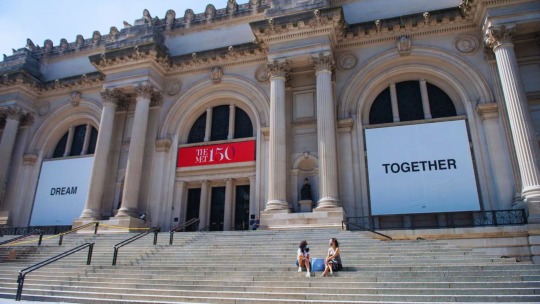
Explore the cultural tapestry woven at the Metropolitan Museum of Art, a sanctuary of artistic brilliance in the heart of New York City. Unearth the treasures of human history spanning 5,000 years, as we embark on a visual odyssey through this iconic institution.
Egyptian Splendors: A Glimpse into Ancient Mysteries
Delve into the enigmatic world of Egypt with the Metropolitan Museum's captivating Egyptian Art collection. Mummies, hieroglyphs, and artifacts from a bygone era await, with the Temple of Dendur standing as a testament to ancient craftsmanship and architectural grandeur.
European Elegance: A Canvas of Timeless Masterpieces
Immerse yourself in the richness of European art as you traverse the halls adorned with masterpieces by Rembrandt, Vermeer, and Van Gogh. From the Renaissance to the Impressionist era, witness the evolution of artistic expression in the European Paintings collection.
American Tapestry: Chronicles of a Nation's Artistic Journey
The American Wing invites you to witness the unfolding narrative of American art, from colonial times to the present day. Iconic works like Emanuel Leutze's "Washington Crossing the Delaware" and sculptures by Augustus Saint-Gaudens punctuate this chronicle of creativity.
Eastern Elegance: A Panorama of Asian Artistry
Embark on a journey through the East with the Asian Art department, showcasing a breathtaking array of artifacts from China, Japan, and Korea. From ancient ceramics to contemporary installations, the collection provides a comprehensive view of Asian artistic traditions.
Time Travel at The Met Cloisters: A Medieval Escape
Step into the ethereal realm of The Met Cloisters, nestled in Fort Tryon Park. This medieval European haven offers a unique experience surrounded by art and architecture from a bygone era. Gardens, chapels, and cloisters beckon, creating a serene atmosphere.
Beyond Art: A Symphony of Decorative Arts and More
The Met goes beyond conventional art forms, housing an impressive collection of decorative arts, textiles, and musical instruments. Explore the diversity within the museum's walls, where every corner reveals a new facet of human creativity.
Dynamic Presentations: Special Exhibitions and Educational Initiatives
The Met constantly evolves with special exhibitions that illuminate specific themes, artists, or periods. These exhibits provide a fresh lens through which to view rare and extraordinary pieces, ensuring a dynamic and ever-changing experience for visitors.
Education Hub: Nurturing Art Enthusiasts of All Ages
The Met's commitment to education is evident in its diverse programs and resources. From guided tours to online exhibits, the museum strives to make art accessible and engaging. Conservation efforts ensure the preservation of delicate artworks, fostering a cultural legacy.
Central Park Reverie: A Post-Art Stroll
Situated on the edge of Central Park, the Met offers not just a cultural feast but also a picturesque setting. After exploring the vast galleries, take a leisurely stroll through the park, reflecting on the beauty encountered within the museum's walls.
In conclusion, the Metropolitan Museum of Art is a cultural beacon that captivates and inspires. Its commitment to preserving, presenting, and educating about art makes it an enriching destination. Whether you're a seasoned art connoisseur or a casual observer, a visit to the Met promises an unforgettable journey through the wonders of human creativity.
1 note
·
View note
Text
Mayan Marvels to Pacific Shores: Your Ultimate Guatemala Vacation
Guatemala, a country nestled in the heart of Central America, beckons travelers with a mesmerizing blend of Mayan marvels and Pacific shores. From the ancient archaeological wonders that whisper tales of the past to the pristine beaches that invite relaxation, a journey through Guatemala promises an ultimate vacation experience. This guide unfolds the narrative of your ultimate Guatemala vacation, navigating through the cultural treasures and coastal serenity that define this Central American gem.

Exploring Mayan Marvels
Tikal: Ancient Splendor in the Jungle
Embark on your Guatemala adventure by stepping into the heart of ancient Mayan splendor at Tikal. Deep within the Petén region's dense jungles, Tikal stands as one of the most significant archaeological sites in the world. Towering pyramids, temples, and palaces emerge from the lush greenery, telling the tales of a sophisticated civilization that once thrived here.
The Great Plaza, flanked by impressive structures, offers a panoramic view of Tikal's grandeur. The Temple of the Jaguar and Temple IV, piercing the treetops, become vantage points to witness the jungle's vast expanse. Exploring Tikal is a journey through time, an immersive experience that connects modern travelers with the ancient mysteries of the Maya.
Antigua Guatemala: Colonial Elegance
Transition from ancient wonders to colonial elegance as you make your way to Antigua Guatemala. Surrounded by three volcanoes, this UNESCO World Heritage Site captivates with its well-preserved colonial architecture, cobblestone streets, and pastel-colored facades. The city exudes a timeless charm that reflects its Spanish colonial heritage.
Wander through the Parque Central, where the iconic Arco de Santa Catalina frames the volcanoes in the background. Visit the Cathedral of Santiago and the Palace of the Captain Generals, architectural marvels that stand as testaments to Antigua's colonial past. The local markets add vibrancy, showcasing indigenous crafts and traditional textiles. Antigua Guatemala becomes a living canvas where the colonial elegance of the past mingles with the pulse of contemporary life.
Lake Atitlán: Highland Tranquility
Continue your journey to Lake Atitlán, a highland gem often described as one of the most beautiful lakes globally. Nestled among volcanoes, the lake's tranquil waters reflect the towering San Pedro, Tolimán, and Atitlán volcanoes. Surrounded by indigenous villages, Lake Atitlán becomes a haven for cultural immersion and serene relaxation.
Explore lakeside villages like San Marcos La Laguna, known for its spiritual retreats, or Santiago Atitlán, where bustling markets showcase the richness of indigenous traditions. Take a boat ride across the lake, witnessing the highlands' breathtaking beauty. Lake Atitlán offers a tranquil escape, inviting travelers to unwind amidst the natural wonders of Guatemala's highlands.
Venturing to the Pacific Shores
El Paredon: Surf, Sun, and Serenity
Transitioning from the highlands to the Pacific coast, discover the hidden coastal gem of El Paredon. This laid-back fishing village has evolved into a haven for surf enthusiasts and seekers of tranquility. With consistent waves and uncrowded surf breaks, El Paredon has earned a reputation as a surfer's paradise.
Surf along the Pacific waves, engage in lessons with local instructors, or simply bask in the coastal serenity. The evenings in El Paredon unfold with breathtaking sunsets, painting the skies with warm hues. The village's authentic charm and close-knit community spirit offer a genuine experience of coastal Guatemala. El Paredon becomes a sanctuary where surf, sun, and serenity harmonize to create the perfect coastal escape.
Monterrico: Pristine Pacific Beauty
Conclude your ultimate Guatemala vacation with a visit to Monterrico, a coastal town renowned for its pristine beaches and volcanic black sand. Along the shores of the Pacific, Monterrico invites travelers to indulge in relaxation and natural beauty. The Reserva Natural de Monterrico, a sanctuary for sea turtles, adds a touch of wildlife conservation to the coastal experience.
Immerse yourself in the tranquility of Monterrico's beaches, where the Pacific waves provide a soothing soundtrack. Participate in turtle conservation efforts, releasing hatchlings into the sea during the nesting season. Monterrico's untouched beauty and serene ambiance make it a fitting destination to wrap up your Guatemala vacation.
Conclusion: Guatemala's Tapestry of Wonders
In conclusion, your ultimate Guatemala vacation unfolds as a journey through a tapestry of wonders — from the ancient marvels of Tikal and the colonial elegance of Antigua Guatemala to the highland tranquility of Lake Atitlán and the coastal serenity of El Paredon and Monterrico. Guatemala, with its rich history, diverse landscapes, and welcoming communities, promises an immersive experience that transcends typical travel. Whether you seek cultural exploration, adventure, or relaxation, your Guatemala vacation becomes a mosaic of moments, each unveiling a different facet of this Central American jewel.
0 notes
Photo










The Poncho
Art and Tradition
curators :Javier Eguiguren Molina, José Eguiguren Molina, Roberto Vega
Vega & Eguiguren, Buenos Aires 2001, 72 pages, ISBN 9789879838631
euro 80,00
email if you want to buy :[email protected]
This catalogue has been published in conjuction wtih the exhibition “The Poncho, Art and Tradition” held at the National Decorative Art Museum. Buenos Aires, Argentina, October/November 2001 . Ponchos from private and public collections. Covers these textiles from Precolumbian Andes to contemporary central America.
orders to: [email protected]
twitter: @fashionbooksmi
flickr: fashionbooksmilano
instagram: fashionbooksmilano
tumblr: fashionbooksmilano
#poncho#precolumbian textiles#contemporary central american textiles#peruvian textiles#tessuti etnici#fashion inspiration#textile books#fashionbooks#fashionbooksmilano
8 notes
·
View notes
Photo

Springtime in Brooklyn by Nancy Rosoff, Andrew W. Mellon Senior Curator, Arts of the Americas
As I look out my window at the falling rain, I know that these April showers will soon be followed by May’s flowers. The vibrant colors of budding trees and blossoming flowers give us hope that we will overcome the current crisis, and the world will be rejuvenated, stronger, and more unified. The following works from the Brooklyn Museum’s diverse collection celebrate the arrival of Spring and our hope for a healthy and more peaceful world.
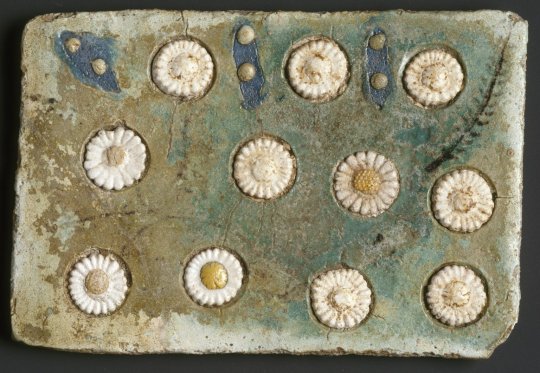
Brightly colored plants and flowers made of faience once decorated the walls of the Great Palace of king Akhenaten at Amarna. Sun light and the disk of the sun itself became the focus of religious worship in the Amarna period (1353-13336 B.C.E.). The floral motifs of these tiles were meant to evoke rebirth of life brought about by the sun. See the artwork in our open collection.
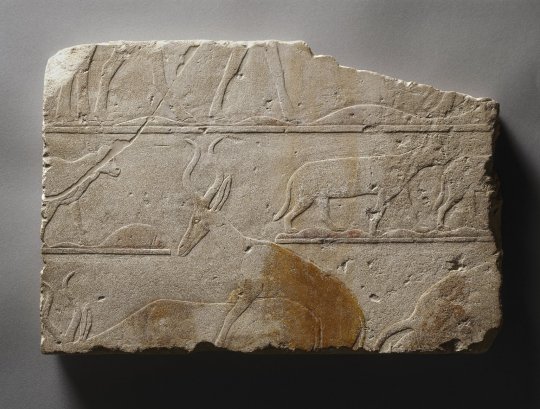
While the Nile was revered as a life-giving place, the desert was also teeming with nature. Here one can see animals breeding in their desert environs. To the right, a feline is showing interest in another feline. At the lower left, a male antelope, mounting his mate, rears his head into the row above. At the lower right, the hindquarters of an antelope giving birth and the emerging head of her calf are partly preserved. The bovine calf at center left completes this depiction of the cycle of life. See the artwork in our open collection.
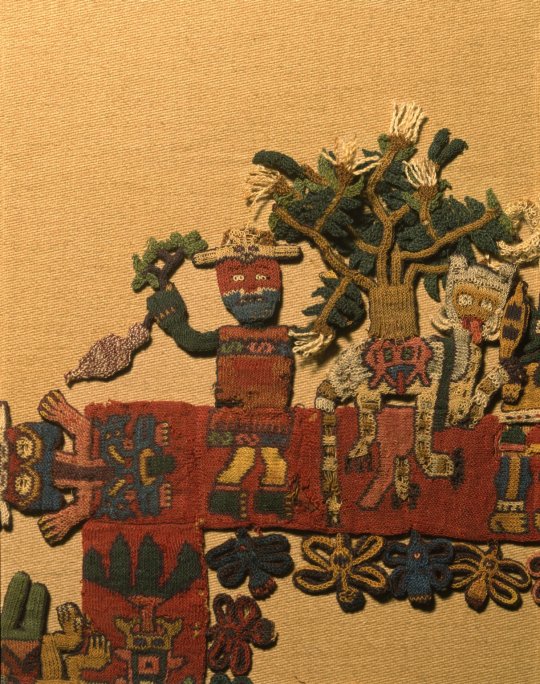
This detail from a Nasca mantle not only illustrates some of the plants and animals native to Peru’s South Coast, but it also conveys how the society’s spiritual beliefs are connected to agricultural seasons. The blossoming huarango tree seen here represents life and is shown growing out of a human trophy head on the back of a pampas cat. The trophy head symbolizes death but it is also a germinating seed from which life sprouts in a never-ending cycle of life, death, and rebirth. See the artwork in our open collection.

This late-seventeenth-century painting from viceregal Peru shows Saint Joseph standing hand-in-hand with the Christ Child in a field of blooming flora and enclosed within a border of bright carnations and lilies. Saint Joseph’s popularity flourished at this moment in the Spanish Americas as he embodied ideals of fatherhood, marriage, divinity, and masculinity. Here, he holds a stem of white lilies, which symbolize his holiness and purity. See the artwork in our open collection.
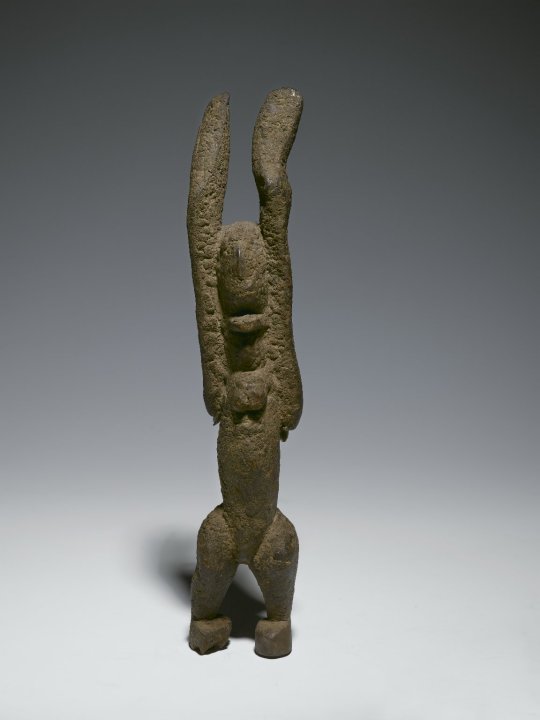
This sculpture would have served as a means for people to contact spiritual intermediaries for aid. Its raised arms are said to refer to prayers for rain, crucial to survive and thrive in arid the Mopti Region of Mali. See the artwork in our open collection.
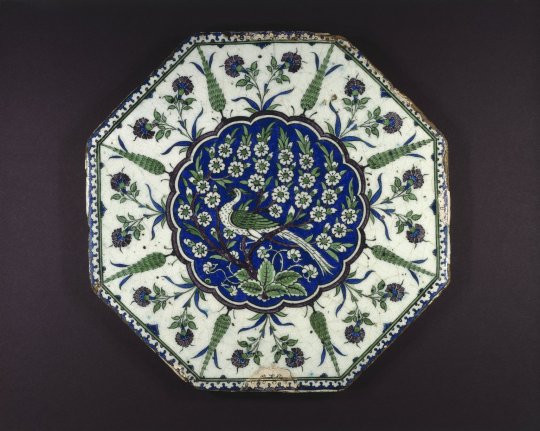
The use of naturalistic floral motifs, such as carnations, tulips, and hyacinths, was a trademark of the design workshop of the Ottoman court in Istanbul in the mid-sixteenth century. This design principle was adopted in central and distant areas of the empire and applied to different media, such as manuscript illuminations made in Istanbul, textiles made in Bursa, and tiles made in Iznik and Damascus. This octagonal tile from Syria brings the beauty of spring indoors permanently. See the artwork in our open collection.
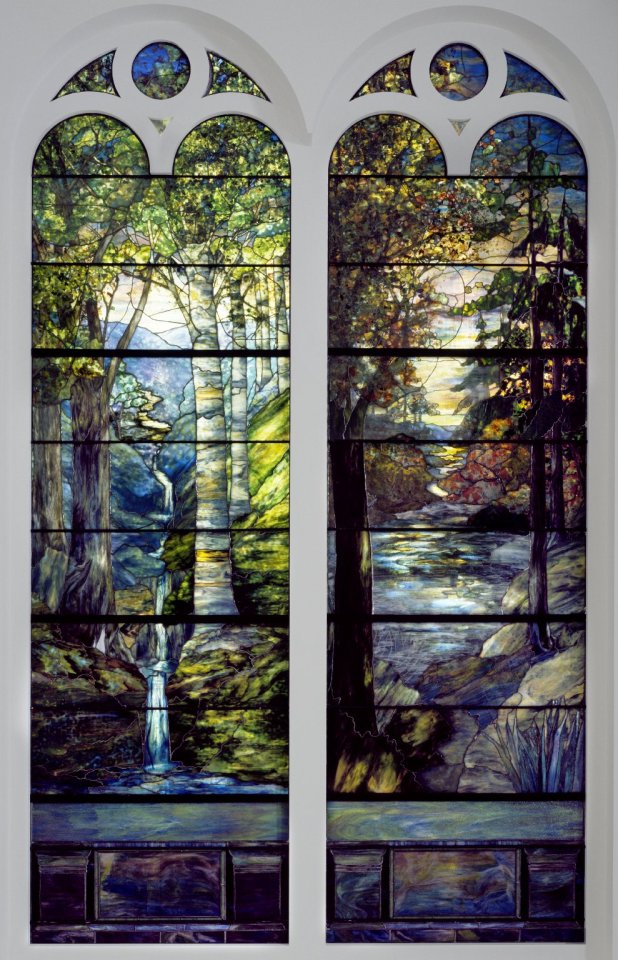
Vibrant greens and blues bring a spring woodland scene inside the Museum, creating an eternal verdant landscape. The effects of changing sunlight or a passing cloud can animate the glass used to depict the stream, tree trunks and leaves. Originally installed in the Universalist Church of Our Father at Classon and Atlantic Avenues in Brooklyn, the windows were purchased by the All Souls Universalist Church on Ocean Avenue and installed in 1945, before coming to the Brooklyn Museum a few years ago. Tiffany Studio was extremely skilled at creating panoramas that open onto lush, brilliantly colored vistas. See the artwork in our open collection.
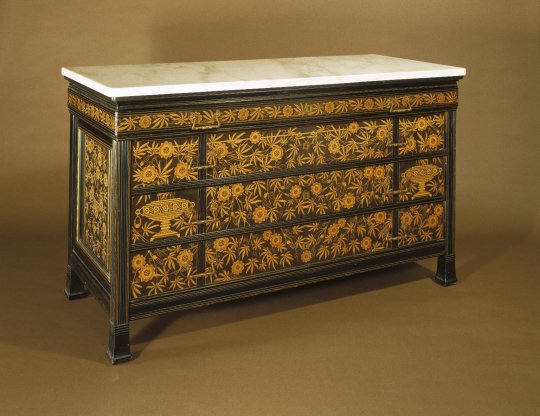
This elaborately decorated cabinet brought ever-blooming flowers into the owner’s bedroom. Inspired by Japanese precedents, New York’s most important late-19th-century furniture manufacturing firm Herter Brothers employed different colored woods to create the densely packed, abstracted flowers and leaves on this luxurious, yet functional chest-of-drawers. See the artwork in our open collection.
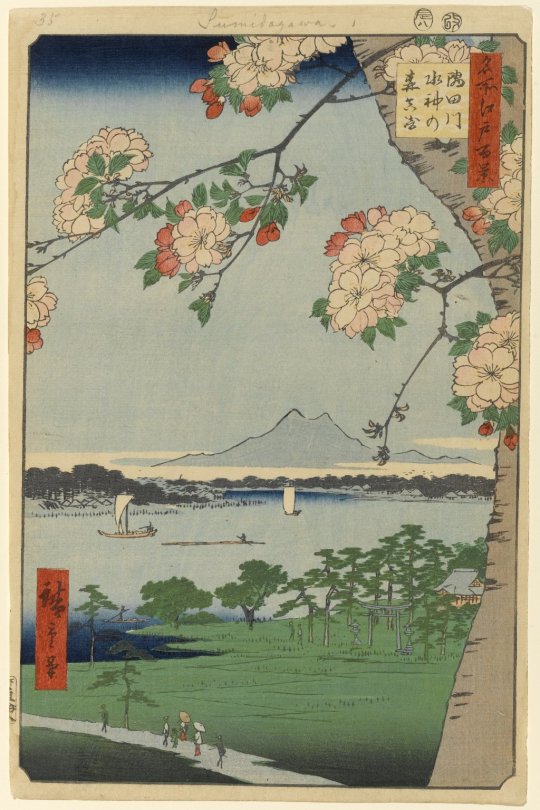
In the Japanese tradition, cherry blossom season is a time for celebration: the world wakes up after a long winter and people head outside to gather under the pink-and-white canopies created by trees that seemed barren only a week or two earlier. This year the picnics were cancelled, but in nature the show goes on whether there’s an audience or not. See the artwork in our open collection.
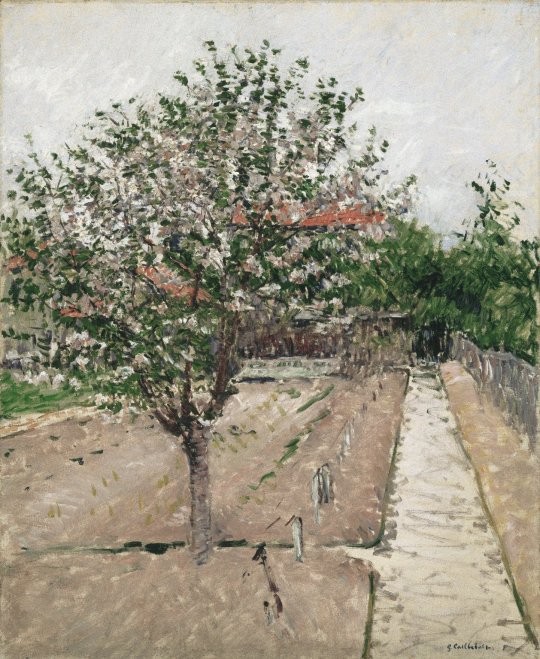
In this painting, Gustave Caillebotte offers a glimpse of his private garden in Petit Gennevilliers, a small village on the Seine opposite Argenteuil. The apple blossoms are rendered in thick touches of paint, which contrast with the sketchy treatment of the path that leads toward the denser foliage beyond the tree. See the artwork in our open collection.

Nothing celebrates Spring more than this dazzling child’s cap with its delicate beadwork on vibrant rose-colored velvet. It was lovingly made by the mother or female relative of a little girl who would have worn it with pride during special occasions. See the artwork in our open collection.
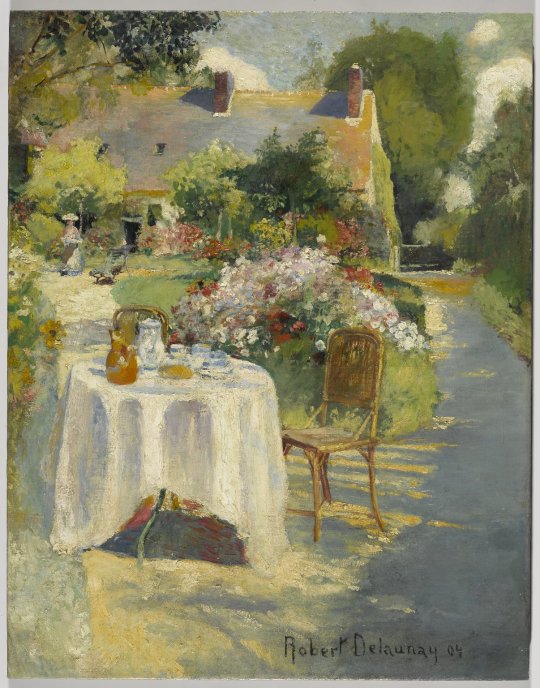
A table set with bread and coffee in a blooming garden along a sun-dappled path conjures the pleasures of the warmer months to come. Robert Delaunay would become known later in his career for more abstract work, but in this early painting the 19 year old artist was still working under the influence of Impressionism. See the artwork in our open collection.
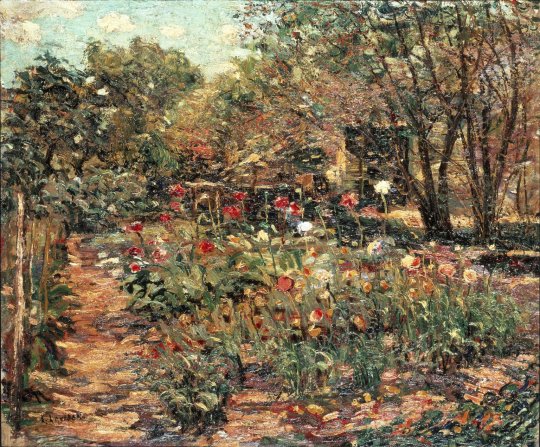
Redolent with the sweet scent of peonies, American Impressionist Ernest Lawson paints his flowerbeds in a dazzling display of jewel like tones in the Cos Cob art-colony located along the Connecticut shore. See the artwork in our open collection.
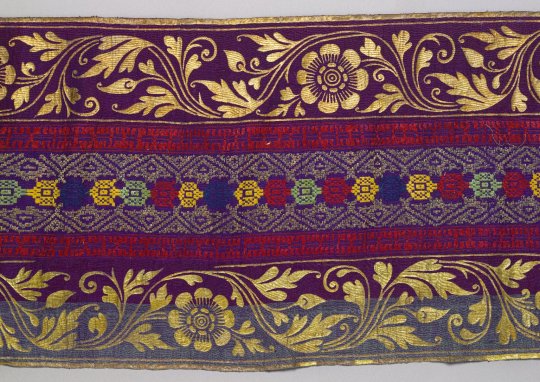
This Balinese cover features bright brocade rosettes in purple, blue, red, yellow, and green. The gilded gold overpaint features patra cina designs borrowed from Chinese floral patterns. Together, they create a glittering textile that is awash with color and floral motifs. See the artwork in our open collection.

One of the Brooklyn Museum’s most important Japanese paintings is a folding screen showing a group of urbanites walking together, followed by a musician and a servant with a big box. The only clue that they are heading to a cherry-blossom-viewing picnic comes from a woman who extends a branch of flowering cherry back toward a group of men. Attached to the branch is a long strip of paper of the type used traditionally in Japan for writing poems. What does the poem strip say? We don’t know, but it seems fair to guess that it serves as an invitation to romance. The screen reminds us that the spring tradition of partying beneath the cherry trees wasn’t solely about communing with nature. See the artwork in our open collection.
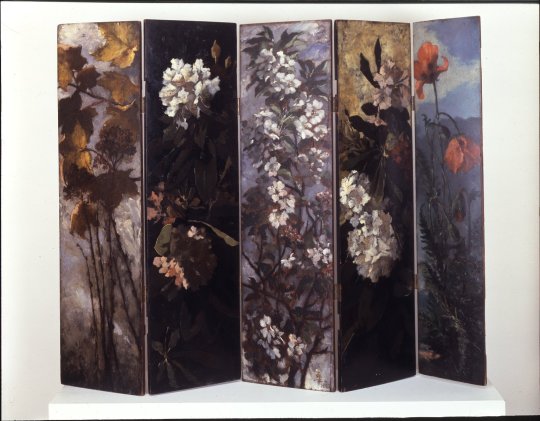
Inspired by Japanese folding screens or byōbu, Elizabeth Boott Duveneck’s five panels bring the natural world into the interior of the house depicting all four seasons from Autumn Foliage to Apple blossoms throughout the year. See the artwork in our open collection.
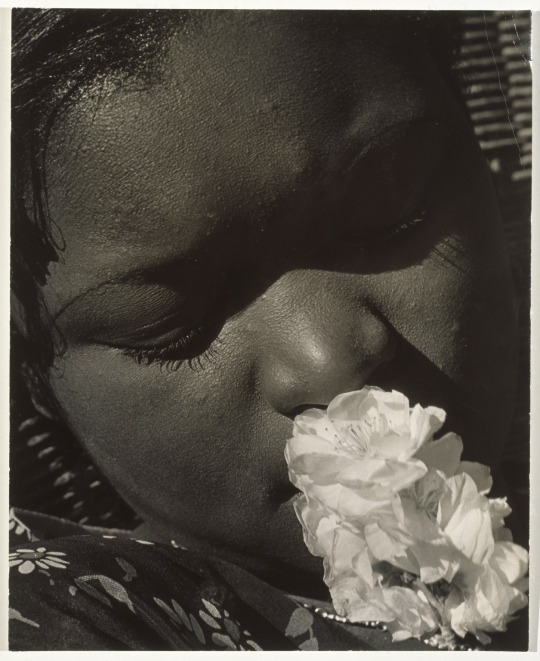
Beginning in the early 1930s, Consuelo Kanaga became one of few white photographers to make artistic portraits of Black Americans. This closely cropped and sharply focused image of a girl’s face with a flower was likely included in Group f.64’s inaugural exhibition in 1932, which announced a new realist direction in photography. Considered radical in its time, Frances with a Flower explores powerful ideas about beauty, gender, and race. See the artwork in our open collection.
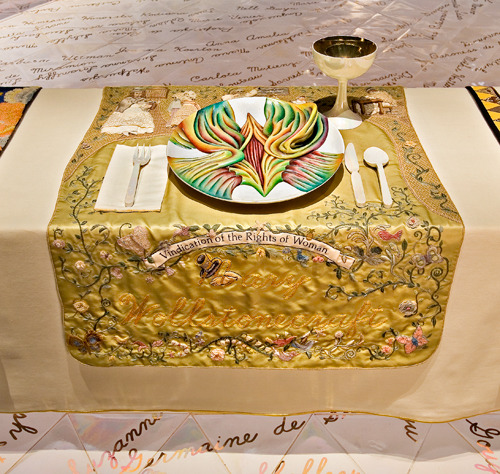
Mary Wollstonecraft was a renowned women’s rights activist who authored "A Vindication of the Rights of Woman," (1792), a classic of rationalist feminism that is considered the earliest and most important treatise, advocating for equality and education for women. Akin to the nature of Spring, Wollstonecraft's life symbolized the fruition of a legacy—from which infinite linages of women continue to reap the fruits of her labor. See the artwork in our open collection.
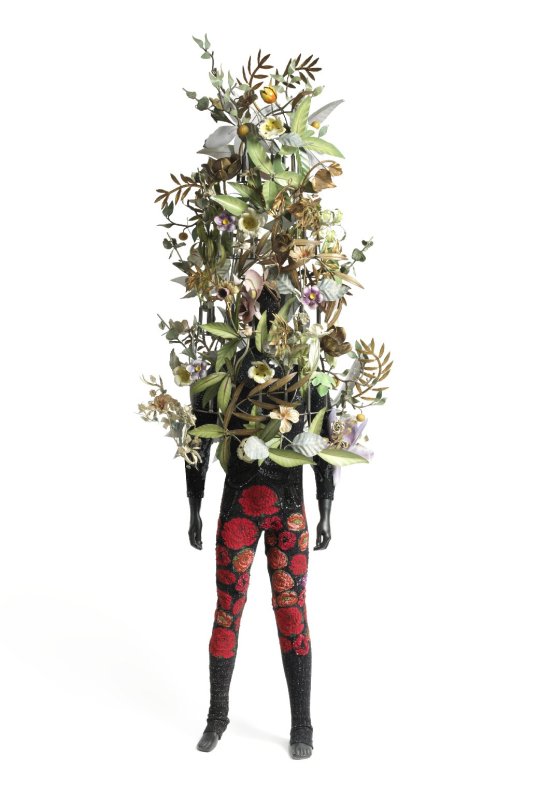
With rose-patterned leggings and an elaborate floral armature/headdress, Nick Cave’s Soundsuit transforms the human body into a lush garden. Since the early 1990s, Cave has been fabricating inventive sculptures out of scavenged materials, which he often overlays with beadwork, stitching, and other embellishments. One of the first, crafted from twigs, was made to be worn and created a rustling sound, which led to the eventual name of such works: Soundsuits. Cave’s costumes draw from a variety of sources, including both African and Caribbean traditions of masquerade. See the artwork in our open collection.
Posted by Nancy Rosoff with contributions from the Curators and Curatorial Assistants of African, American, Ancient Egyptian, Arts of the Americas, Asian, Contemporary, Elizabeth A. Sackler Center for Feminist Art, and Islamic Art
Photos: Gary Alan Bukovnik (American, born 1947). Rhododendrum, 1980. Lithograph on paper. Brooklyn Museum, Gift of the artist, 81.15.2. © Gary Alan Bukovnik(Photo: Brooklyn Museum); Tile with Floral Inlays, ca. 1352-1336 B.C.E. Faience. Brooklyn Museum, Gift of the Egypt Exploration Society, 35.2001. Creative Commons-BY (Photo: Brooklyn Museum); Relief with Desert Scene, ca. 2472-2455 B.C.E. Limestone, pigment. Brooklyn Museum, Charles Edwin Wilbour Fund, 64.147. Creative Commons-BY (Photo: Brooklyn Museum); Nazca. Mantle ("The Paracas Textile"), 100-300 C.E. Cotton, camelid fiber. Brooklyn Museum, John Thomas Underwood Memorial Fund, 38.12; Cuzco School. Saint Joseph and the Christ Child, late 17th-18th century. Oil on canvas. Brooklyn Museum, Museum Expedition 1941, Frank L. Babbott Fund, 41.1275.191 (Photo: Brooklyn Museum); Dogon. Nommo Figure with Raised Arms, 11th-15th century (possibly). Wood, organic sacrificial material. Brooklyn Museum, The Adolph and Esther D. Gottlieb Collection, 1989.51.39. Creative Commons-BY (Photo: Brooklyn Museum); Octagonal Tile Depicting Peacock in Prunus Tree, 16th century. Ceramic; fritware, painted in black, cobalt blue, green, and manganese purple under a transparent glaze. Brooklyn Museum, Gift of Jack A. Josephson, 1990.21. Creative Commons-BY (Photo: Brooklyn Museum); Tiffany Studios (1902-1932). Dawn in the Woods in Springtime, 1905. Stained glass window. Brooklyn Museum, Gift of All Souls Bethlehem Church, 2014.17.1. Creative Commons-BY; Herter Brothers (American, 1865-1905). Chest-of-Drawers, ca. 1880. Ebonized cherry, other woods, modern marble top, brass. Brooklyn Museum, Modernism Benefit Fund, 1989.69. Creative Commons-BY (Photo: Brooklyn Museum); Utagawa Hiroshige (Ando) (Japanese, 1797-1858). Suijin Shrine and Massaki on the Sumida River (Sumidagawa Suijin no Mori Massaki), No. 35 from One Hundred Famous Views of Edo, 8th month of 1856. Woodblock print. Brooklyn Museum, Gift of Anna Ferris, 30.1478.35 (Photo: Brooklyn Museum); Gustave Caillebotte (French, 1848-1894). Apple Tree in Bloom (Pommier en fleurs), ca. 1885. Oil on canvas. Brooklyn Museum, Bequest of William K. Jacobs, Jr., 1992.107.2 (Photo: Brooklyn Museum); Woodlands. Child's Cap, ca. 1890s. Velvet, cloth, beads. Brooklyn Museum, Gift of the Edward J. Guarino Collection in memory of Josephine M. Guarino, 2016.11.2. Creative Commons-BY; Robert Delaunay (French, 1885-1941). In the Garden (Dans le jardin), 1904. Oil on canvas. Brooklyn Museum, Gift of Iris and B. Gerald Cantor, 86.28 (Photo: Brooklyn Museum); Ernest Lawson (American, 1873-1939). Garden Landscape, ca. 1915. Oil on canvas. Brooklyn Museum, Bequest of Laura L. Barnes, 67.24.10 (Photo: Brooklyn Museum); Cover, 19th or early 20th century. Silk, pigment. Brooklyn Museum, Dick S. Ramsay Fund, 45.183.110. Creative Commons-BY; Cherry Blossom Viewing Picnic, ca. 1624-1644. Ink, color and gold leaf on paper. Brooklyn Museum, Gift of Frederic B. Pratt, 39.87. Creative Commons-BY (Photo: Brooklyn Museum); Elizabeth Boott Duveneck (American, 1846-1888). Apple Blossoms, 1882. Oil on wood panel. Brooklyn Museum, Gift of Joan Harmen Brown, Mr. and Mrs. William Slocum Davenport, Mrs. Lewis Francis, Samuel E. Haslett, William H. Herriman, Joseph Jefferson IV, Clifford L. Middleton, the New York City Police Department, Mrs. Charles D. Ruwe, Charles A. Schieren, the University Club, Mrs. Henry Wolf, Austin M. Wolf, and Hamilton A. Wolf, by exchange, Frank Sherman Benson Fund, Museum Collection Fund, Dick S. Ramsay Fund, Carll H. de Silver Fund, John B. Woodward Memorial Fund, and Designated Purchase Fund , 2005.54.3 (Photo: Brooklyn Museum); Consuelo Kanaga (American, 1894-1978). Frances with a Flower, early 1930s. Gelatin silver photograph. Brooklyn Museum, Gift of Wallace B. Putnam from the Estate of Consuelo Kanaga, 82.65.10 (Photo: Brooklyn Museum); Judy Chicago (American, b. 1939). The Dinner Party (Mary Wollstonecraft place setting), 1974–79. Mixed media: ceramic, porcelain, textile. Brooklyn Museum, Gift of the Elizabeth A. Sackler Foundation, 2002.10. © Judy Chicago. Photograph by Jook Leung Photography; Nick Cave (American, born 1959). Soundsuit, 2008. Mixed media. Brooklyn Museum, Mary Smith Dorward Fund, 2009.44a-b. © Nick Cave (Photo: Image courtesy of Robilant Voena)
#virtualtour#springtime#spring#brooklyn museum#museums#brooklyn#virtual tour#art#art museum#bkmtours#virtual tours
569 notes
·
View notes
Text
Art History - Feminine Art
For this week's blog post about representation of female character in art I have chosen an artist I had no prior knowledge of until researching after the lecture today.
We studied three female artists today and discussed what impact and message the chosen pieces had on our views of the feminine identity.
These were:
A: Jenny Saville, Propped (1992)
B: Sarah Lucas 'Pauline Bunny' (1997) . Assemblage.
C: Cindy Sherman Untitled B, untitled (C 1975).
I chose a different artist to write about today: Judy Chicago is an American artist born in 1939 (as Judy Cohen), and the piece chosen is The Dinner Party, a large installation work (1463 × 1463 cm) created over 4 years (1974–79) made of Ceramic, porcelain, textile.
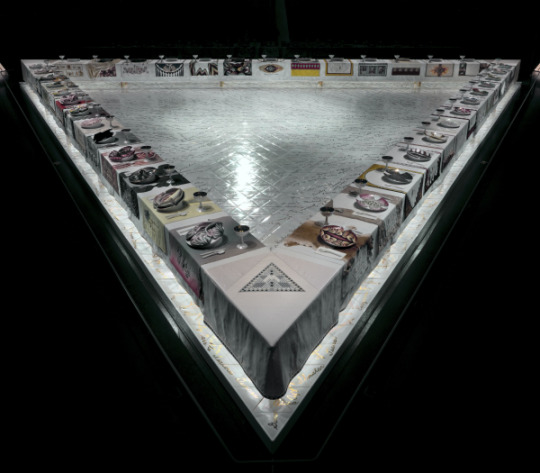

It is sited permanently in the Brooklyn Museum (a Gift of the Elizabeth A. Sackler Foundation) and forms the centrepiece for the Elizabeth A. Sackler Center for Feminist Art which occupies the 4th floor of this museum.
‘The Dinner Party’ has been described as an iconic piece of 20th century feminist art. Created in a triangular table form, it is 'set' with has 39 plates representing famous women including; Georgia O’Keeffe, Virginia Woolf, Emily Dickinson, Elizabeth I, Theodora, and Sappho.
If you look closer at the plates, they resemble female genitalia with raised central motifs that are based on vulvar and butterfly forms. Each place setting has been created in the 'style' of the person honoured there. The artist has also written 999 names in gold on the marble floor beneath the table.
The installation incorporates many different art forms and media, some typically associated with 'femininity' such as embroidery, but also includes, gold chalices and utensils, china-painted porcelain plates, and tiling work.
This piece is honouring over 1000 women and their sexuality, historical significance, and, I think most importantly, their individuality. They are not just here to serve, reproduce and conform, they each have their own talents, personality and voice, and this piece goes some way to helping us to understand that.
The artist changed her name in the 1960′s to represent the place of her birth, and helped set up the first Feminist Art Program at California State University, Fresno, in 1970. In 1971 with, with artist Miriam Schapiro, she co-founded the Feminist Art Program at California Institute of the Arts, Valencia.
In 1972 they created with their students a collaborative installation and performance space called Womanhouse - transforming an abandoned building into a house representative of women’s experiences. This was the first public exhibition of feminist art.
Together, the students and lead artists worked to build an environment where women’s conventional social roles could be shown, exaggerated, and subverted.*
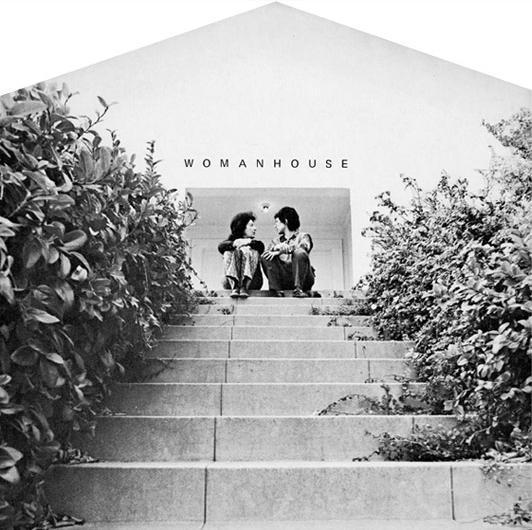
Only women were allowed to view the exhibition on its first day, after which the exhibition was open to all viewers. There was a dining room installation space in this house and I wonder if this influenced the creation of her iconic piece over the next few years?
So, in Summary, I feel that this artist has represented female experiences and values and has challenged many sterotypes and patriarchal societal views on what women do and how they are valued.
Sources:
https://www.thecollector.com/feminist-art/
https://nmwa.org/art/artists/judy-chicago/
https://www.brooklynmuseum.org/exhibitions/dinner_party
https://en.wikipedia.org/wiki/Womanhouse
*(source Smith, Terry (Terry E.) (2011). Contemporary art : world currents. Upper Saddle River [N.J.]: Prentice Hall. ISBN 9780205034406. OCLC 696321779.)
#art history#feminist art#judy chicago#jenny saville#sarah lucas#helen shapiro#female artists#strodecollegeartdepartment
12 notes
·
View notes
Text
Color Harmony
In celebration of the milestone 20th anniversary of the National Design Awards, this week’s Object of The Day posts honor National Design Award winners.
In 1959 Louis Kahn was commissioned to design a new building for the First Unitarian Church of Rochester, New York. The congregation had met for many years in a building of special architectural quality, designed in 1859 by Richard Upjohn, a leading 19th-century architect and founder of the American Institute of Architects. When that building had to be demolished for downtown redevelopment, the congregation felt a responsibility to replace it with one by a leading 20th-century architect, giving the community a notable example of contemporary architecture. Kahn’s finished building had a cubic concrete interior with no windows or interior detailing, but light streamed in from the four towers at each corner of this central space.
Jack Lenor Larsen recounts meeting with Kahn at Larsen’s Gramercy Park Apartment in 1962 to discuss the possibility of creating a series of textile hangings for the side walls of the church in order to correct the reverberating sound and also “to provide visual incident on three of the walls.”(1) Kahn wanted a color harmony using only red, blue, and yellow, and Larsen gave him a subtle spectrum of colors that also included orange, green, and purple just by using different shades of colors in the warp. The wool was handspun in Mexico and ultimately handwoven in the United States. In the weft, Larsen used a clear and relatively stiff monofilament that produced a desirable rigidity in the vertical wall panel. Batting underneath helped to absorb sound.
Most likely this particular piece was part of some earlier samples that tested the combination of colors. The final series of hangings range from warm yellow to cooler blues and grays and add to the church interior prismatic colors that seem to emanate from the natural light above.
(1) Jack Lenor Larsen: A Weaver’s Memoir by Jack Lenor Larsen (Harry N. Abrams, Inc., New York: 1998), pp.39-40
from Cooper Hewitt, Smithsonian Design Museum https://ift.tt/32q7fGn via IFTTT
1 note
·
View note
Photo





Summer exhibitions @ The New Museum by j- No Via Flickr: LES Manhattan NYC June 25, 2019 artists featured are: "Mika Rottenberg: Easypieces,” “Marta Minujín: Menesunda Reloaded,” “Lubaina Himid: Work from Underneath”, "Melanie Crean, Shaun Leonardo, and Sable Elyse Smith: Mirror/Echo/Tilt";, and "Diedrick Brackens: Darling Divined"
Last Tuesday, The New Museum held a morning Press Preview and breakfast to inaugurate their new summer exhibitions. The artists featured are: "Mika Rottenberg: Easypieces , ” “Marta Minujín: Menesunda Reloaded,” “Lubaina Himid: Work from Underneath”, "Melanie Crean, Shaun Leonardo, and Sable Elyse Smith: Mirror/Echo/Tilt", and "Diedrick Brackens: Darling Divined."
Diedrick Brackens: "Darling Divined"Diedrick Brackens (b. 1989, Mexia, TX) constructs intricately woven textiles that speak to the complexities of black and queer identity in the United States. Interlacing diverse traditions, including West African weaving, European tapestries, and quilting from the American south, Brackens creates cosmographic abstractions and figurative narratives that lyrically merge lived experience, commemoration, and allegory. He uses both commercial dyes and unconventional colorants such as wine, tea, and bleach, and foregrounds the loaded symbolism of materials like cotton, with its links to the transatlantic slave trade.
Melanie Crean, Shaun Leonardo, and Sable Elyse Smith: "Mirror/Echo/Tilt" examines the language and gestures used to describe experiences of arrest and incarceration. Culminating a four-year collaboration between the artists, the exhibition premieres a multichannel video installation that depicts performances they developed with participants in intensive workshops and filmed largely in decommissioned prisons, empty courthouses, and other psychically charged architectural spaces in New York City.
Mika Rottenberg: " Easypieces ” Employing absurdist satire to address the critical issues of our time, Rottenberg creates videos and installations that offer subversive allegories for contemporary life. Her works interweave documentary elements and fiction, and often feature protagonists who work in factory-like settings to manufacture goods ranging from cultured pearls ( NoNoseKnows , 2015) to the millions of brightly colored plastic wholesale items sold in Chinese superstores (Cosmic Generator, 2017). The exhibition presents several of her recent video installations and kinetic sculptures, and premieres a new video installation, Spaghetti Blockchain (2019), that explores ancient and new ideas about materialism and considers how humans both comprise and manipulate matter. Together, the works in the exhibition trace central themes in Rottenberg’s oeuvre, including labor, technology, distance, energy, and the interconnectedness of the mechanical and the corporeal.
Marta Minujín: " Menesunda Reloaded ” Over the past sixty years, the epoch-defining Argentinian artist Marta Minujín (b. 1943, Buenos Aires, Argentina) has developed happenings, performances, installations, and video works that have greatly influenced generations of contemporary artists in Latin America and beyond. Minujín combines elements of experimental theater, film and television, advertising, and sculpture to create total environments that place viewers at the center of social situations and confront them with the seductiveness of media images and celebrity culture. Emerging in the 1960s as one of the strongest voices in Argentinian art, Minujín has often refused to make lasting objects, instead developing her work in opposition to institutional structures. Her simultaneously monumental and fragile works challenge conventions of art while testifying to her unyielding engagement with both radical artistic forms and the artifices of popular culture. Minujín’s capacity to inspire awe and surprise has solidified her reputation as a pioneer of Latin American conceptual art.
Lubaina Himid: "Work from Underneath ”A pioneer of the British Black Arts Movement of the 1980s and ’ 90s, Himid has long championed marginalized histories. Her drawings, paintings, sculptures, and textile works critique the consequences of colonialism and question the invisibility of people of color in art and the media. While larger historical narratives are often the driving force behind her images and installations, Himid’s works beckon viewers by attending to the unmonumental details of daily life. Bright, graphic, and rich in color and symbolic referents, her images recall history paintings and eighteenth-century British satirical cartoons. In many works, the presence of language and poetry—sometimes drawn from the work of writers such as Audre Lorde, Essex Hemphill, or James Baldwin—punctuates the silence of her images with commands, instructions, or utterances that are at once stark and tender. The exhibition’s title, “Work from Underneath,” borrows from the dictums of health and safety manuals but doubles as a subversive proclamation. With the sculptures, paintings, textiles, and sound works that comprise the exhibition, Himid examines how language and architecture generate a sense of danger or safety, fragility, or stability.
#Flickr#@newmuseum#newmuseum#artmuseum#museum#exhibition#artists#DiedrickBrackens#LaMenesunda#MartaMinujin#MikaRottenberg#LubainaHimid
2 notes
·
View notes
Link
You will not be surprised to be told that Tucker Carlson’s new book, Ship of Fools: How a Selfish Ruling Class Is Bringing America to the Brink of Revolution, contains a series of attacks on diversity, immigration, feminism, and “identity politics.” You may, however, be surprised to be told that the book contains high praise for Ralph Nader, quotes from Studs Terkel, laments the disappearance of the anti-capitalist left, and presents Jeff Bezos as one of its central villains. Carlson has written a book that is as staunchly nationalist as one would expect. Yet it’s also a little bit socialist.
Carlson’s basic framework would commonly be described as “populism.” There are the people, and then there are the “ruling class” elites. The rich and powerful care only about themselves. They do not care about Middle America, and have presided over the opioid epidemic, the hollowing out of industrial towns, and exploding inequality. Meanwhile, ordinary workers suffer. At times, he almost sounds like Bernie Sanders. His analysis is persuasive, well-written, and often funny. It’s also terrifying, because elsewhere in the book, Carlson makes it clear: he wants a white-majority country, thinks immigrants are parasitic and destructive, misses traditional gender hierarchies, and dismisses the significance of climate change. Carlson’s political worldview is destructive and inhumane. Yet because it has a kernel of accuracy, it will easily tempt readers toward accepting an alarmingly xenophobic, white nationalist worldview. Carlson’s book shows us how a next generation fascist politics could co-opt left economic critiques in the service of a fundamentally anti-left agenda. It also shows us what we need to be able to effectively respond to.
First, let’s look at the parts that are most right, and perhaps most unexpected. In an analysis almost identical to that of leftists like Thomas Frank, Carlson says that Republicans and Democrats are now both beholden to corporate power. Sometime in the 1990s, Carlson says, he began wondering “why liberals weren’t complaining about big business anymore,” and had started celebrating “corporate chieftains” like Steve Jobs, Bill Gates, and the Google guys. Ralph Nader should be a hero to all liberals, spending his days “greeting a parade of awestruck liberal pilgrims” from a retirement home. Instead, he is “reviled,” even though “every point Nader made was fair” and “some were indisputably true.” Suddenly “both sides were aligned on the virtues of unrestrained market capitalism… left and right were taking virtually indistinguishable positions on many economic issues, especially on wages.”
The “prolabor” Democrats, Carlson says, were “empathetic and humane” and “suspicious of power.” But today they have disappeared, and the party of the New Deal is now a party of Wall Street. Carlson points out that Hillary Clinton won wealthy enclaves like Aspen, Marin County, and Connecticut’s Fairfield County (the hedge fund capital of the country). “Employees of Google, Facebook, Apple, Microsoft, and Amazon donated to Hillary over Trump by a margin of 60-to-1,” and while “Seven financial firms donated 47.6 million to Hillary,” they gave Trump “a total of $19,000, about the price of a used pickup.”
As a result, Carlson says, Democrats are now largely silent on labor issues: “When was the last time you heard a politician decry Apple’s treatment of workers, let alone introduce legislation intended to address it?” Corporations make vaguely “socially liberal” noises, like decrying gun violence and being pro-LGBT, and as a result escape criticism for mistreating their workers or contributing to economic inequality. Carlson cites Uber, which has prominent liberal Arianna Huffington on its board and has had to commit to reforming its “bro culture.” And yet it still treats its drivers like crap:
“[Uber is] running an enormously profitable business on the backs of exploited workers… An obedient business press [has] focused on the ‘flexibility’ Uber’s contractors supposedly enjoyed. … [But] Feudal lords took more responsibility for their serfs than Uber does for its drivers… Uber executives weren’t ashamed… They sold exploitation as opportunity, and virtually nobody called them on it.”
What happens, Carlson says, is that corporations “embrace a progressive agenda that from an accounting perspective costs them nothing.” They are, in effect, purchasing “indulgences from the church of cultural liberalism.” Sheryl Sandberg published Lean In and Mark Zuckerberg is floated as a possible Democratic presidential candidate, but Facebook is an evil corporation to its core. Sean Parker has admitted that Facebook was engineered to be addictive, that its designers thought: “How do we consume as much of your time and conscious attention as possible?… We need to sort of give you a little dopamine hit every once it a while.. To get you to contribute more content.” Carlson notes that the company commits “relentless invasions of the public’s privacy,” and that epidemiologists have linked the product “with declining psychological and even physical health.” Carlson writes:
“Evidence has mounted that Facebook is an addictive product that harms users, and that Zuckerberg knew that from the beginning but kept selling it to unknowing customers. Those facts would be enough to tarnish most reputations, if not spark congressional hearings. Yet Zuckerberg remains a celebrated national icon.”
We know Facebook is manipulating people’s emotions to sell advertising, and yet we still get headlines like “How To Raise The Next Mark Zuckerberg.” Or look at Amazon. Jeff Bezos supported Hillary Clinton for president, yet “no textile mill ever dehumanized its workers more thoroughly than an Amazon warehouse.” Carlson asks: “when was the last time you heard a liberal criticize working conditions at Amazon?… “Liberals and Jeff Bezos [are now] playing for the same team.” Successful businessmen “pose as political activists,” and pitch their products as woke. That way: “affluent consumers get to imagine they’re fighting the power by purchasing the products, even as they make a tiny group of people richer and more powerful. There’s never been a more brilliant marketing strategy.” He goes on:
“The marriage of market capitalism to progressive social values may be the most destructive combination in American economic history. Someone needs to protect workers from the terrifying power of market forces, which tend to accelerate change to intolerable levels and crush the weak. For generations, labor unions filled that role. That’s over. Left and right now agree that a corporation’s only real responsibility is to its shareholders. Corporations can openly mistreat their employees (or “contractors”), but for the price of installing transgender bathrooms they buy a pass. Shareholders win, workers lose. Bowing to the diversity agenda is a lot cheaper than raising wages.”
Carlson mocks the “socially liberal” Davos elite who hand-wring about inequality while reaping its fruits. He points to the example of Chelsea Clinton, who talked nobly about her values (“I was curious if I could care about [money] on some fundamental level, and I couldn’t… That wasn’t the metric of success that I wanted in my life”) before buying a $10 million, 5,000 square foot apartment in the Flatiron District that spanned an entire city block. Chelsea Clinton’s career, for Carlson, shows how contemporary believers in “meritocracy” benefit from an unjust and nepotistic system: Clinton was paid $600,000 a year as a “reporter” for NBC despite appearing on the network for a sum total of 58 minutes. The bubble of privilege that many elites inhabit was exemplified in Hillary Clinton’s 2016 campaign, which suggested that “Things in America are Fine.” (The slogan was actually “America Is Already Great.”) Carlson is not wrong here: Hillary Clinton herself was so out of touch that she is still saying things like “I won the places that represent two-thirds of America’s gross domestic product… So I won the places that are optimistic, diverse, dynamic, moving forward.”
Carlson also says that there has been a troubling tendency for both sides to embrace the military-industrial complex. Key Democratic figures supported the Iraq War (e.g. Feinstein, Kerry, Clinton, Biden, Edwards, Reid, Schumer). It was New York Timesreporters who contributed to scaremongering about Saddam in the leadup to the war, the New York Times op-ed page where you can find contributions like “Bomb Syria, Even If It’s Illegal” or “Bomb North Korea, Before It’s Too Late,” and New York Times columnist Thomas Friedman who said that Iraq War had been “unquestionably worth doing” because it told Middle Easterners to “suck on this.” Barack Obama (who was given the Nobel Peace Prize, Carlson says, for “not being George W. Bush”) killed thousands of people with drones, including American citizens, prosecuted whistleblowers, kept Guantanamo open, and failed to rein in the vast global surveillance apparatus. Hillary Clinton pushed aggressively for military action in Libya, which destabilized the country. There is a D.C. consensus, Carlson says, and it is pro-war. Some of the book’s most amusing passages come when Carlson flays neoconservative hacks like Max Boot and Bill Kristol, who have now become allies of the Democratic Party in paranoia about Russia. Boot’s career, he says, publishing articles like “The Case for American Empire” and advocating invasion after invasion, shows us how “the talentless prosper, rising inexorably toward positions of greater power, breaking things along the way.” The hawkish consensus is no joke, though, and Carlson says he misses the liberal peaceniks, who “were right” when they warned that “war is not the answer, it’s a means to an end, and a very costly one.”
To many on the left, everything Carlson says here will be familiar. The phenomenon he’s pointing to, by which Democrats and Republicans both became free market capitalists, has a name: neoliberalism. Larry Summers was quite open about it when he said that “we are now all Friedmanites.” Carlson’s point about how corporations whitewash exploitative practices by appearing socially progressive is one leftists make frequently (see, for example, Yasmin Nair’s essay “Bourgeois Feminist Bullshit” and Nair and Eli Massey’s “Inclusion In The Atrocious“). The foreign policy stuff is a little off: it’s not that Democrats used to be pacifists, since the Vietnam tragedy was initiated by JFK and expanded by Lyndon Johnson. Empire has always been a bipartisan project, antiwar voices in the minority. Aside from the suggestion that this is new, it’s accurate to say that American elites have largely embraced the projection of American military power.
But Carlson is not going to be joining the Sanders 2020 campaign. His book has a dark side: a deep suspicion of cultural progressivism, inclusion, and diversity. Carlson believes that liberal immigration policies have been imposed because they serve elite interests (Democrats get votes and Republicans get cheap labor for Big Business). As a result, the fabric of the country is fraying. He writes:
Thanks to mass immigration, America has experienced greater demographic change in the last few decades than any other country in history has undergone during peacetime… If you grew up in America, suddenly nothing looks the same. Your neighbors are different. So is the landscape and the customs and very often the languages you hear on the street. You may not recognize your own hometown. Human beings aren’t wired for that. They can’t digest change at this pace… [W]e are told these changes are entirely good… Those who oppose it are bigots. We must celebrate the fact that a nation that was overwhelmingly European, Christian, and English-speaking fifty years ago has become a place with no ethnic majority, immense religious pluralism, and no universally shared culture or language.
To some people, what Carlson writes here may not seem racist. And like many conservatives, he resents having what he sees as common sense treated as bigotry. I don’t think there’s any way around it, though: Carlson’s problem is that the United States looks different, that it’s not “European” any more and has no “ethnic majority.” He’s explicitly talking the language of ethnicity: it’s destabilizing that we’re not a white-majority country anymore. This isn’t simply about, say, the “Judeo-Christian ethic” or embracing the “American idea.” If that were the case, then it would be hard to make a case for why we shouldn’t let in the Catholic members of the migrant caravan, who love American culture and want to march across the border saying the Pledge of Allegiance. The problem is that they are not European, that they change the look of the place, that they disrupt the “ethnic majority.” Europeans are the real Americans, the ones that hold the fabric of the nation together, and minorities, people who are different, threaten to undo that fabric.
(Continue Reading)
43 notes
·
View notes
Photo







In 1960, notable textile artist and interior designer Alexander Girard brought to life La Fonda del Sol, a Latin-American-themed restaurant located on the ground floor of the Time & Life Building in New York City. Commissioned by innovative restaurateur Joseph Baum, Girard designed the opulent interior, evocative of a contemporary branded space, to transport guests to an imagined world through extraordinary decoration and attention to detail.
He drew inspiration from personal interest in Latin culture and history, and his passion for the art and ritual of dining. In collaboration with Girard, Charles and Ray Eames designed the La Fonda pedestal chairs for the space with a shorter seat height to allow direct view of the tableware.
The restaurant featured a melding of cultures represented through elements including a Mexican ceramic tile fountain, marble from Cuba, carved wooden doorways from Brazil, and a Pre-Columbian stylized sun motif that hung above the adobe-enclosed cocktail lounge. Objects from his extensive personal collection of Central and South American folk art adorned the walls and he insured great care was taken to represent the cultures with detail and respect.
Reference: Wright Auction
#la fonda del sol#wright auction#Alexander girard#eames#charles eames#ray eames#Joseph baum#New York city#tableware#interior design#art#mexico#cuba#brazil#folk art
3 notes
·
View notes
Text
Decorate with Location Rugs
If you're aiming to upgrade and also rejuvenate an area in your house rapidly, easily and also reasonably, take into consideration making use of a rug. A designer carpet is a furnishing and home-decorating product. While carpets serve an useful feature as a floorcovering, they have the capability to change the feel and look of every space as well as are terrific for a quick option to troubles with your existing carpets. With increasingly more houses making use of wood or ceramic tile flooring, rug have actually seen an increase in appeal, as they can protect hardwood floors or wall-to-wall carpets. Carpets likewise have the ability to link elements of a space together. An area rug is an excellent method to promptly heat the space up also. They could add a wonderful remarkable color and design to every room. They specify a sitting arrangement perfectly, in a sense creating an island in the room to earn it more intimate as well as welcoming. You can alter rugs when the periods adjustment and take them with you if you relocate. Decorator carpets are prominent with all residence diy decoraters. Rug Color Styles as well as Patterns Color is always the most vital facator when embellishing. Your picked shade or pattern of rug should act as a comparison to the already present theme and components within that room or location. If your space has a good deal of bright as well as vibrant shades, pick a neutral color and a refined style for the rug. If the colors of the area are soft and neutral, you can add rate of interest with a brilliant carpet as well as a remarkable layout. When selecting the pattern on the carpet, remember it has to not encounter patterns on the wallpaper, window treatments, pillows, and also other textiles in the room. Dark colors add heat, as well as light colors will make the space appear even more sizable. Additionally think about the quantity of traffic through the room or area. If there are youngsters or pet dogs, or the rug will certainly obtain stable usage, dark shades and also elaborate patterns will not show dust as much or as swiftly as light shades. Rug Shapes And Sizes An excellent suggestion when choosing carpet sizes and shape is to make use of covering up tape to specify the space, in order to help you vizualize the carpet in the area. You could also lay sheets. When a rug is to be made use of to cover the majority of the flooring, the very same quantity of poet floor space must be subjected on all sides of the carpet. If your area is uneven in shape, aim to prepare furnishings to extend to the carpet sides. As well as if this is not feasible, ensure at least 2 identical side are subjecting the very same of amount of floor room.

For a rug that is defining a location, there ought to be no more compared to than two feet of empty carpet extending out from behind the furnishings. A rug utilized for specifying is unifying the products placed around it if the rug is huge sufficient to suit a minimum of the front legs of each piece of furniture. A rug for a dining room, must prolong eighteen inches to twenty-four inches beyond the table, with generally a 8- by ten-foot carpet operating in a lot of living rooms as well as dining-room. For small locations, such as coffee tables a six- by four-foot or a six- by nine-foot rug suffices. Carpet Style and also Qualities Contemporary rugs can be found in every range of shade, layout, appearance, dimension, and cost. Consider a rug with a central medallion, if the rug is to be the centerpiece of an area. If the medallion will certainly be concealed generally by a furniture, pick a carpet that has an allover layout, or one with information on its boundaries. Oriental carpets are a term which refers to carpets from any Asian country that are preferred in modern as well as typical residences. A round braided rug, would fit a North American style. Using a Navajo rug, with its geometric styles and level weave, can strengthen a southerly or desert motif. Other Carpet TipsMaintenance is a crucial factor to consider when picking rugs not just for the bathroom, but additionally the kitchen area, the hall, or the area of a youngster. Select layouts and also colors that donít reveal the dust, and are stain resistant and also easy to clean. It is a smart idea to add cushioning under a rug since it will certainly not only maintain the rug from relocating, it will certainly additionally extend its life, soak up noise, as well as make vacuuming simpler. If see more are positioning a carpet over wall-to-wall carpets, pick a thin under-pad coated with a sticky.
1 note
·
View note
Photo
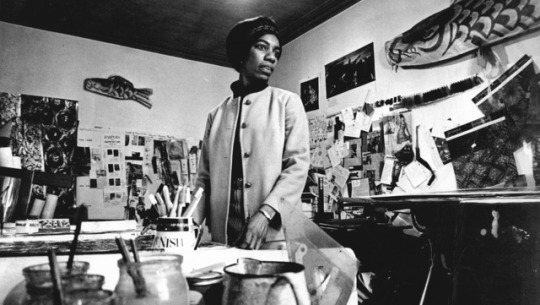
Althea McNish by Libby Sellers
“London, is the place for me,” extolled Lord Kitchener, one of Trinidad’s top calypsonians, as he disembarked the Empire Windrush at Tilbury docks in 1948. As part of a wave of colonial artists drawn to the “mother country” in search of London’s intellectual and creative center, Kitchener captured the optimism and joy the migrants brought with them. That this optimism infiltrated all corners of British life, and specifically the furnishing and fashion fabrics of homes from north to south, east, and west, owes much to Althea McNish. Born in Trinidad’s capital, Port of Spain, and living in London since 1951, within her textiles McNish “tropicalized” the gray British landscape with all the warmth, sunshine and vibrancy of fellow Trinidadian Lord Kitchener. Yet, in comparison with her textile contemporaries, McNish’s contributions to the transformation of postwar Britain have only recently begun to be acknowledged in her adopted country.
Descended from the Meriken settlers (former African American slaves who had fought for the British during the War of 1812), her father was the writer and publisher Joseph Claude McNish, and her mother, a well-regarded dressmaker. She grew up in a world of words, ideas, and fabrics that, from as young as three, she rendered through her passion for painting and drawing. Trinidad at the time was undergoing a cultural renaissance, inspired by the growing demands for independence and the consequent need of its people to forge their own national and cultural identity. As a junior member of the Trinidad Arts Society, McNish was at the center of this thriving scene, staging her first exhibition in her teens and receiving encouragement from her elders including Sibyl Atteck, M. P. Alladin, and Boscoe Holder. Despite her prodigious fine-art talent (she later worked as a cartographer and entomological illustrator with the British government in Trinidad), she dreamed of construction and engineering, studying architecture with a local town planner and taking a particularly unusual interest in septic tanks (developing blueprints for a homemade tank in the family’s backyard).
It was on the back of this fascination that she applied for a scholarship, earning a place at the Architectural Association School in London’s Bedford Square in 1951. She had a seven-year course ahead of her and a grant to last the duration, though dreading the cold, gray British winters McNish transferred to the (shorter) undergraduate courses at the London School of Printing and Graphic Arts. Her interest in textiles was awakened by a visit to an exhibition of student works at the Central School of Art, where British artist Eduardo Paolozzi taught textile design. Through her print studies at the London School of Printing, evening classes at Central, and then postgraduate degree at the Royal College of Art (RCA) she mastered the medium, learning how to develop colorways, create repeats, and prepare her artwork for production as well as learning the production process itself. This relatively rare understanding of both the design and production sides offered McNish inventive freedom, but it also safeguarded her inventiveness. Her ability to speak the printers’ language enabled her to “preserve the integrity of her chosen colors.” McNish added, “Whenever printers told me it couldn’t be done, I would show them how to do it. Before long, the impossible became possible.” At the time, the RCA’s studios were located within the Victoria and Albert Museum. That McNish had chosen to develop her artistic vocabulary surrounded by the museum’s collections, historically garnered from Britain’s Empire, was an awkward oxymoron she claims not to have noticed. Yet McNish is not easily discouraged; her forceful colors are demonstrative of an equally forceful will.
Her most celebrated design was inspired by a weekend visit to the home of her RCA tutors, Edward and Charlotte Bawden, in Great Bardfield, Essex. Sketchbook in hand, she was drawn to the sight of the sun glistening over the fields. As she said of the moment, “In Trinidad, I used to walk through sugar plantations and rice fields and now I was walking through a wheat field. It was a glorious experience.” Through her colorful lens, this bucolic English idyll was transposed, resulting in the design for Golden Harvest (1959). The design and its various colorways were later purchased by Hull Traders, who, through its continued patronage, were to become an important client for McNish, producing short runs of her avant-garde designs.
Her impressionistic lines and blaze of colors burned bright at the 1957 RCA degree show. Pat Bishop, the Trinidadian artist, described how, "Swinging London was on its way...McNish was there to satisfy that need with her big, beautiful splashy prints of every kind of flower and tropical pattern imaginable." Within a day of graduation, she was called to the offices of Arthur Stewart-Liberty, of the eponymous London department store. McNish recalls of the meeting, “He thought Britain was ready for color,” and through such designs as Cebollas (1958) and Hibiscus (1958), he made sure Britain could buy it through him. While her near contemporaries Lucienne Day (1917–2010), Jacqueline Groag (1903–1986), and Marian Mahler (1911–1983) were bringing much needed cheerfulness to the drab days of postwar Britain, McNish’s riot of color was like a volcano erupting through the center of conservative British modernism. “Color was mine,” she declared. Though Day, Groag, and Mahler were to be given more credit.
After their successful 1957 meeting, Stewart-Liberty sent McNish by taxi directly to Zika Ascher, the producer and retailer of extravagant and experimental textiles to the fashion industry. With clients including Cardin, Dior, Schiaparelli, Givenchy, and Lanvin, it was not long before McNish prints such as Tropic and Giselle of 1959 were gracing European fashion magazines. In 1966, when Queen Elizabeth II visited Trinidad in the early days of post-Independence, McNish designed fabrics for her high-profile, official wardrobe.
In her public and professional engagements, she was, as the author Alan Rice suggested, “a rare black and female presence.” Committed to developing her industry and offering a role model for future generations, McNish taught extensively and was a prominent member of various arts councils and bodies. As a founder member of the highly influential Caribbean Arts Movement (CAM) in the mid-1960s, she did much to promote Caribbean artists to the British public, including organizing works by herself and her peers for the 1973 BBC TV magazine program Full House, produced by John La Rose. Her position as the first black British textile designer of repute is something she shrugs off, claiming she never suffered any discrimination due to either her race or gender: “I was so rare, they were dumbfounded.”
In the 1960s, as textile manufacturing declined in the UK, giving rise to the import of plain cotton cloth, the demand for designers to produce patterns for the consumer boom grew. By offering complex patterns that she alone could achieve with the printers, McNish secured contracts with most of the UK’s leading firms, including Cavendish Textiles, Danasco, Heals, and the Wallpaper Manufactures Ltd. (for which she designed the Crystalline print for their Palladio range of 1960). On a 1963 Cotton Board scholarship she traveled to Europe investigating the state of British exports. It was not long before she was selling designs directly to upmarket European firms including Bucol in Lyon and Fede Cheti in Milan among others. Britain’s most successful postwar design consultancy, Design Research Unit, commissioned McNish to design murals for their public and corporate clients including British Rail and the Orient Steam Navigation Company. When the SS Oriana launched in 1959, she sailed McNish’s laminate panels, Rayflowers and Pineapples and Pomegranates, around the world on the walls of its restaurants.
While she effectively retired from textiles in the late 1980s, throughout the intervening years her works have been included in a growing number of exhibitions exploring the under-recognized influence of artists from the African diaspora within British art. Within this context, McNish’s “tiny flowers picked from the British hedgerow transformed into tropical exuberance” take on an entirely new significance, both for the history of postwar textile design and British modernism in general.
Libby Sellers is a design historian, consultant, and curator based in London. The above chapter is an excerpt from her book Women Design, which was published by Frances Lincoln in June 2018.
49 notes
·
View notes